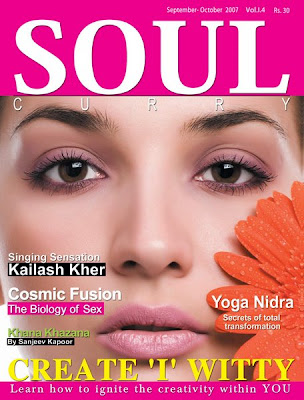 Prana
Prana
• Jalandhara bandha prevents prana from escaping the upper body.
• Uddiyana bandha forces prana up the shushumna nadi.
• Mula bandha, when engaged, prevents apana escaping from the lower body and draws it up to unite with prana.
the chakras - From bottom to top the 7 chakras:
1. Muladhara chakra - at the anus
2. Svadhishthana chakra - at the genitals
3. Manipura chakra - at the navel
4. Anahata chakra - at the heart
5. Vishuddha chakra - at the throat
6. Ajna chakra- between and behind the eyebrows
7. Sahasrara chakra - at the crown of the head
From :Ashtanga Yoga Manual
Monday, February 23, 2009
Prana & the chakras
Posted by Amrit Sen 0 comments
Prana
Prana is a subtle form of energy. Prana literally means “breathing forth” the universal life force. Through practicing asana and pranayama, prana is brought into and stored in the body, increasing vitality. Prana mainly flows through the body in the nadis, or nerve channels of the astral body. Prana exists as a negative energy as well as a positive energy.Prana moves upward and apana moves downward. When the two unite at the muladara chakra (base of spine) kundalini (dormant cosmic energy) is awakened. The most important nadi, or energy channel, (there are 72,000!) is the shushumna nadi which correlates to the spinal cord in the physical body. When kundalini is awakened it starts to move up the shushumna nadi, through the seven chakras toward higher states of consciousness. In ashtanga yoga there are three locks (bandhas) that are engaged throughout the practice to prevent the dissipation of, and direct the flow of prana in the body, and convert it into spiritual energy.
From :Ashtanga Yoga Manual
Posted by Amrit Sen 1 comments
Tuesday, February 17, 2009
Yoga Nidra and consciousness...
 Yoga is probably best known as a comfortable form of relaxation, both on a physical and mental level, but it involves a lot more than that. Relaxation is only the first step.
Yoga is probably best known as a comfortable form of relaxation, both on a physical and mental level, but it involves a lot more than that. Relaxation is only the first step.
It is easy to practice Yoga Nidra. You lie completely motionless on your back, and listen to the instructions given. The technique is used by people who need an effective relaxation. Many use the Yoga Nidra tape or CD without having any other knowledge of yoga or meditation.
Sometimes a person will come to me and say: "I have tried relaxation and it does not work for me. I just cannot relax." It always turns out that the person has used a form of relaxation, where you have to try to imagine that you relax. So instead of deriving benefit from the relaxation, the person concerned gets irritated and worried from making so much effort.
In Yoga Nidra you are never asked to relax - and my experience is that even those people who have previously experienced problems relaxing, find benefit from Yoga Nidra.
Yoga Nidra is equally popular with school kids and senior citizens, and is highly valued in many work places. For beginners, it is an easy way to experience a state of meditation.
Some years ago I taught at a school for young people. The teachers were very surprised when they saw the boys lying completely still on their backs with their eyes closed for twenty minutes.
You can practice Yoga Nidra anytime you want, to improve your concentration, get better rest and renewed energy - and if you sleep poorly at night, to improve your sleep.
Listen to the instructions without making effort or using your willpower. Just follow the instructions with interest and awareness, and let the rest happen by itself.
In the beginning when you practice Yoga Nidra, you may fall asleep - and that is okay - even though the purpose is to stay awake and aware. If for a moment you don't hear the instructions, you may have an experience like you are deeply asleep - but at the same time you know that you are conscious. Generally falling asleep completely is a transitory stage. Gradually you become increasingly present in the deep state.
When you practice Yoga Nidra, it is best to lie with your head towards the north. Your clothes should not be tight. Do not lie on anything too soft, but preferably on an even floor, maybe on a rug, with a light cover over you. If you are prone to falling asleep, keep your hands and feet uncovered or lie without a cover altogether. If you still fall asleep, then let your elbows rest on the floor with your forearms pointing upwards. Each time you are about to fall asleep, your arms will drop down, and you will wake up.
The essence of Yoga Nidra, as with all kinds of real meditation, is awareness - consciousness resting in itself. During Yoga Nidra thoughts, states and dreams may surface. You may have impressions of experiences and emotions from that day or from earlier times in your life. All this you experience, but you don't cling to any of it - and you don't judge it (after all, you also experience when you judge). You let the impressions and thoughts come and go without trying to control them, and you reach not only a relaxed state, but a state where the mind empties and frees itself of all that it does not need. You let the thoughts flow by and disappear like clouds in the sky, making room for inspiration again.
If for a moment you forget to follow the instructions, then do not try to remember what happened at that particular place in Yoga Nidra; just follow the now. When you get carried away by a thought it may easily turn into a dream that carries you into sleep. Because you are in a deep state, it is quite normal for this to happen. As soon as you discover it, then return to the instructions. In this way you get used to staying aware in a deep state.
Yoga Nidra teaches you to consciously experience the different states that you are guided through, eg. Heaviness and lightness. You learn to give in to the different emotions and states. Your mind is being trained in this way and becomes more flexible - and you reach a state of deep rest.
It is important to have guidance from an experienced teacher in a class or on a tape/CD, especially with the long Yoga Nidra, as the relaxation should preferably be the same each time. In this way the subconscious feels secure and relaxes more easily. When you have gotten used to the short Yoga Nidra, you can then take yourself through the instructions mentally, before you turn to the long and deep Yoga Nidra.
The name Yoga Nidra actually represents a state of consciousness, and the technique leads you there. Both mind and body reach the meditative state. You gain an experience that you can use in other contexts; among other things, it can improve your meditation.
What is most important for all kinds of meditation is regularity, preferably a daily practice. Each time you do it, it will be easier to reach the clarity and peace, which support physical health and your presence in everything you do.
By Mira
Posted by Amrit Sen 0 comments





